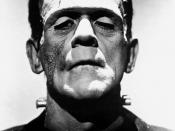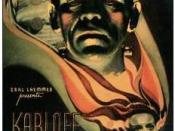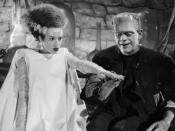Effectively portrayed
Mary Shelley's novel Frankenstein is primarily concerned with presenting the destructive effects of prejudice on innocent soul, who is trying to fit in with society. The novel demonstrates this by displaying the monster's constant rejection by humans, because of his hideous complexion. The film, The Bride of Frankenstein (1935) was constructed to portray the novel and to entertain the people, successfully grasped the theme of the novel. Despite the director's intention to make the film petrifying, The Bride of Frankenstein develops the theme effectively by stressing the monster's human traits with the people he encounters, despite the society spurning him.
The earlier film, Frankenstein (1932) neglects to show the monster's human traits. This film focuses more on entertaining the audience and showing the monster as a barbaric creature that has no intentions on being virtuous. The manner in which this film demonstrates these malicious qualities is by showing how the monster rejects kindness from the very moment he was created.
For example, when the monster was first created, his creator was very kind to him by treating him like a baby. His creator accepted him with open arms and tried to be a father figure. But the monster disregards the creator's kindness and instead of welcoming him, as a humane creature would do, he attacks him. Another example of the monster's barbaric traits is when the monster encounters a sweet little girl. The little girl and him were perfect for each other because they both were very lonely. The girl's father didn't pay any attention to her; therefore she was so desperate that she wanted to befriend the monster. However, the monster had different kinds of plans; instead of returning her virtuous acts, he viciously murdered her. From the very moment the creature was introduced in the...


